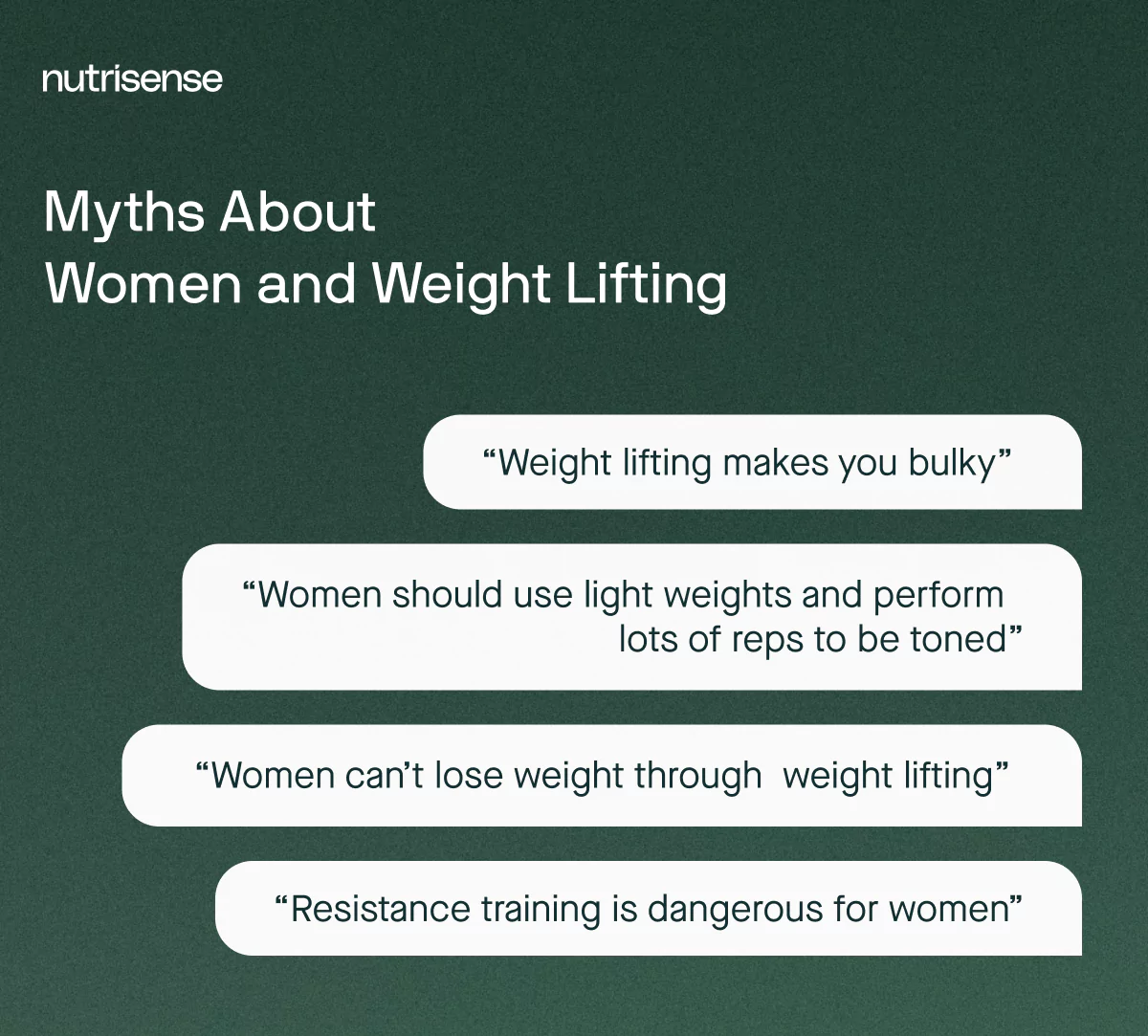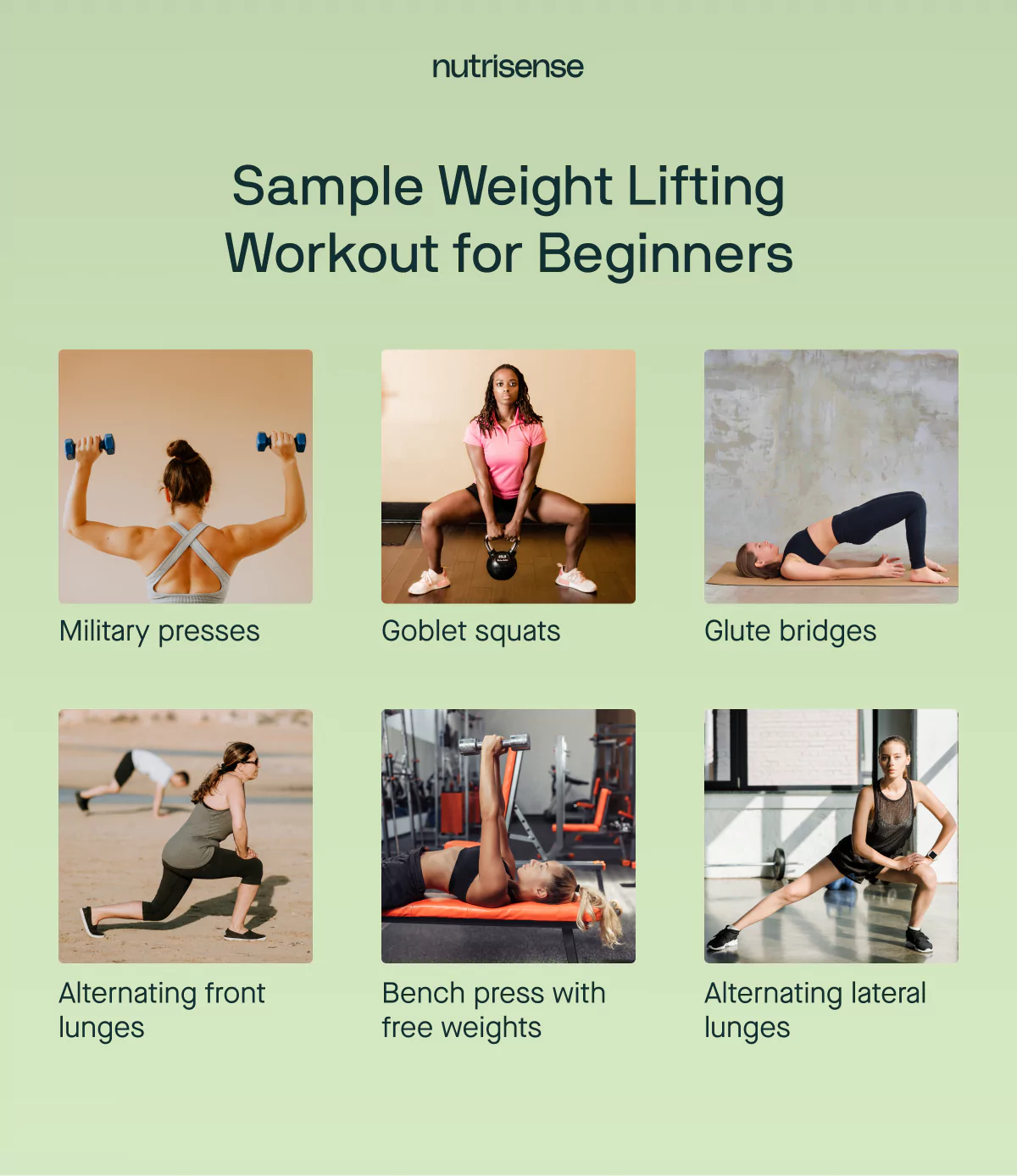Weight Lifting for Women: The Essential Guide for Beginners

Key Takeways
If you’re someone who runs daily or who frequents the gym but makes a beeline for the cardio machines, you’re in good company. Lifting weights can be intimidating for many women, and through no fault of their own. There are so many myths about strength training as a woman that it can be difficult to know where to start, not to mention confusing to know how to do it “right.”
The bottom line is that building muscle is beneficial, no matter what your goals are. Strength training, or resistance training, includes bodyweight and band exercises in addition to weight lifting and can transform your confidence, mood, body composition, and health (for the better!).
In this article, we’ll highlight reasons to lift weights, calm any fears you might have about strength training, and map out a few sample routines to help you get started.
6 Key Benefits of Strength Training for Women

No matter what phase of life you’re in, strength training comes with scientifically proven health benefits. From building lean muscle mass and bone density when you’re young to softening the cognitive changes that can come with menopause, there are plenty of reasons to consider adding strength training into your routine.
A Stronger Nervous System
Lifting weights trains more than just your muscles—it also strengthens communication between your brain and muscles and improves your proprioception, or awareness of your body in space. For example, when you’re new to training, the force you exert tends to be greater than the muscle mass you’ve just started to gain.
A recent study found that the neural adaptations that are involved stem from circuits in your primary motor cortex as well as the reticulospinal tract in the spinal cord. This suggests that strength training may ultimately lead to a stronger or more efficient nervous system.
Healthier Bones

Bone density decreases with age in both men and women. Combined with a sharp drop in estrogen at the onset of menopause, in women this can lead to osteoporosis, a condition characterized by decreased bone mineral density and increased risk of fractures.
Lifting weights is the most effective way to improve bone strength and mineral density through your late twenties and to maintain or improve bone density throughout life. The stress of tugging and pushing on bone that occurs during strength training stimulates osteoblasts, our bone-forming cells, to build stronger, denser bones.
Balanced Glucose Levels
Skeletal muscle hypertrophy, or an increase in the size of your muscles, improves overall metabolic health, including your body’s ability to maintain glucose balance. One reason for this is that your body stores glucose as glycogen in your muscles, so naturally, the more muscle you have, the more glucose will be able to be stored there.
Some studies suggest that including both cardio and strength training in your routine may help you to see more improvement in glycemic regulation than either form of exercise alone.
Improved Metabolic Health and Body Composition

Strength training boosts your metabolic rate, which increases your energy expenditure even while you’re at rest. While cardiovascular exercise achieves this as well, strength training also increases mitochondrial density, enhancing oxidative capacity, or how efficiently your muscles oxidize fat for fuel.
As a result, your body becomes more metabolically flexible, such that it no longer relies on glucose as its only fuel source. Alongside increased resting metabolism, this can improve body composition by supporting fat burning.
Reduced Risk of Heart Disease
Cardiovascular exercises receive all the starlight for preventing heart disease—and while cardio is an important part of any exercise routine, strength training can protect against cardiovascular conditions, too. A study published in the Journal of the American Heart Association found that high muscle mass is associated with lower cardiovascular disease and mortality rates in both men and women—another reason to train for hypertrophy.
Improved Cognitive Function and Mental Health
Strength training has many neuroprotective effects, including reduced inflammation and increased expression of brain-derived neurotrophic factor, a neuromodulator that is essential for learning and memory. It has also been shown to significantly reduce symptoms of anxiety and depression.
Debunking Common Myths about Women and Weight Lifting

If you still have reservations about lifting weights or building strength, that’s natural—many of the following myths have been societal messages you may have grown up with. Let’s debunk some of the most common misconceptions about weight lifting for women.
Weight Lifting Makes You “Bulky”
A concern many women have prior to beginning a strength training practice is that lifting weights might make them strong, but it will also make them look “bulky.” Lifting weights can help boost your metabolic rate and can facilitate weight loss as you build strength, and can also help you to develop lean muscle mass.
It’s important to note that there is a way to train for strength and a way to train for size. If you’re looking to gain muscle mass, studies show that completing six to 12 reps using a moderate weight is effective. If strength is your goal, go for fewer reps one to five with a heavier weight.
Resistance And Weight Training Is Dangerous For Women
Just like men, women can benefit from building strength in many ways. There is no evidence that resistance training is dangerous. To avoid accidental injuries, start with a weight that is challenging but not painful to lift, gradually increase that amount by no more than 10 percent per week, and give your muscles adequate rest between workouts (at least two days) by alternating which muscle groups you train on different days.
Women Can’t Lose Weight Through Lifting
As we noted above, lifting weights boosts your metabolic rate and increases your body’s ability to burn fat. By lifting weights, it can become easier to lose fat while conserving or building lean muscle mass, which can support weight loss.
Women Should Use Light Weights And Do A Lot Of Reps To Be Toned
If your fitness goal is to look toned, doing a lot of reps with light weights can be effective. However, it won’t help you to gain strength or put your body into a state of metabolic exertion that’s challenging enough to experience many of the positive effects of following a strength training program.
Lifting moderately heavy weights a few times a week can be beneficial if your health goal is to look toned, or build lean muscle.
A Beginner’s Guide to Weight Lifting Exercises
By now, you may feel convinced of the benefits of strength training (or at least more informed). When you’re ready, pick up a pair of dumbbells—or even two full water bottles—and try out one of the sample exercise plans we’ve put together for women at different ages and fitness levels.
Keep in mind that these are general recommendations, and depending on your body’s unique composition, these exercises may not be exactly what your body needs. As you transition into strength training, keep an open mind, experiment (safely) with new exercises, and most of all, design a full-body workout plan that feels fun.
Keep in mind that rest days are essential for proper recovery and for reducing the risk of injury. Working with a personal trainer when getting started can also be a great way to build confidence early on and improve your form.
Sample Beginner Workout for Women

For some women, especially beginners, the ideal workout routine incorporates lighter weights, higher repetitions, and a full range of upper body and lower body movement patterns to help with body composition and biomechanical changes in the body.
Do three sets of 12 to 15 reps of the following exercises, using light dumbbells. Rest for 10 seconds between exercises and for one to two minutes between sets.
- Military presses
- Goblet squats
- Alternating front lunges
- Glute bridges
- Bench press with free weights
- Alternating lateral lunges
Sample Intermediate Weight Lifting Workout for Women

For a woman who is a little more advanced when it comes to lifting, both power and muscle gain are important for improving strength, bone density, and body composition. Try out an exercise circuit like the one below, performing four to six sets of 8 to 12 reps, using light to moderately heavy dumbbells as needed.
Rest for 10 seconds between exercises and for two to three minutes between sets.
- Push ups
- Barbell squats
- Assisted pull-ups
- Single arm rows
- Kettlebell goblet squats
- Sumo squats with pulse (hold one dumbbell in each hand)
- Romanian deadlifts
Sample Beginner Workout for Post-Menopausal Women

For a woman going through or who has gone through menopause, strength training helps to conserve bone density and muscle in the wake of hormonal changes. Here’s another beginner’s circuit to try out.
Aim for three to five sets of 10 to 12 reps, using light to moderately heavy dumbbells as needed. Rest for 10 seconds between exercises and for one to two minutes between sets.
- Biceps curls
- Triceps kickbacks
- Lateral shoulder raises
- Walking lunges
- Leg presses or smith machine squats
- Lat pull downs
- Crunches
The Role of Nutrition for Weight Lifting
Increasing your protein intake is essential to any strength training routine. Protein accelerates recovery by helping muscles to repair themselves and grow stronger. This translates to feeling less sore between workouts and being able to properly recover before the next time you train the same muscle group.
Basic Diet Tips for Women Starting a Weight Lifting Routine
- Prioritize protein: Make sure you’re consuming enough high-quality, protein-rich foods throughout the day. Treat yourself to a protein smoothie after your workouts.
- Fuel your body: Eat a balanced, whole foods diet to provide your body adequate macro and micronutrients for optimal performance.
- Hydrate: Hydration will help you to feel strong during your workout and to recover well. Here are some hydration tips to try.
Find the right Nutrisense programto turn insight into progress.
Go Beyond Glucose Data with Nutrisense
Your glucose can significantly impact how your body feels and functions. That’s why stable levels are an important factor in supporting overall wellbeing. But viewing glucose isn't enough. Nutrisense, you’ll be able to learn how to use your body's data to make informed lifestyle choices that support healthy living.
One-to-one coaching
Sign up to access insurance-covered video calls to work with a glucose expert: a personal registered dietitian or certified nutritionist who will help tailor your lifestyle and diet to your goals.
Monitor and measure what matters
With the Nutrisense CGM Program, you can monitor your glucose with health tech like glucose biosensors and continuous glucose monitor (CGM)s, and analyze the trends over time with the Nutrisense App. This will help you make the most informed choices about the foods you consume and their impact on your health.
Find your best fit
Ready to take the first step? Start with our quiz to find the right Nutrisense program to help you take control.

Jordyn has a bachelor’s degree in biology, a graduate degree in Human Nutrition and completed a dietetic internship at the Memphis VA. She's a dietitian at Nutrisense, and has experience working as a clinical dietitian at a VA medical center specializing in oncology and at the Mayo Clinic, working with a wide range of patients ranging from neonates in the NICU to adult ICU.




